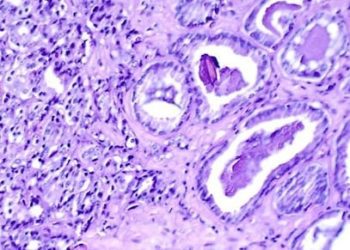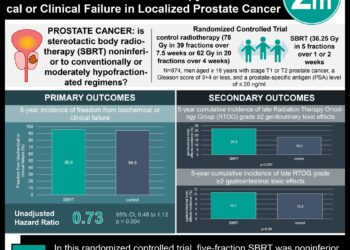Systemic Therapy and Stereotactic Body Radiotherapy in Oligoprogressive Breast Cancer or Lung Cancer
1. Progression-free survival in NSCLC was found to be significant with HR 0.41 compared to breast cancer which was non-significant with HR 0.78.
2. Grade 2 or worse adverse events occurred 41% in the standard-of-care group vs 62% in the SBRT group.
Evidence Rating Level: 1 (Excellent)
Study Rundown: The treatment paradigm for metastatic cancer involves systemic therapies, but interest has grown in using ablative radiotherapy for oligometastatic disease (limited number of metastatic sites). Recent studies have shown some improved survival with stereotactic ablative radiotherapy (SBRT), however the efficacy remains unclear, prompting a randomized, prospective, phase 2 study focusing on breast cancer and NSCLC to assess the benefits of ablative radiotherapy for oligoprogressive metastatic cancer. The primary endpoint was progression-free survival (PFS) and secondary outcomes included overall survival (OS), safety, and quality of life (QoL). Median PFS was 3.2 months in the standard-of-care group versus 7.2 months in the SBRT group, with an HR 0.53 (p=0.0035). There was more benefit found in patients with NSCLC (HR 0.41, p=0.0039) than with breast cancer (HR 0.78, p=0.43). Median OS was similar across both groups with an HR 0.99, p=0.40), and remained similar in disease-specific subgroups. The SBRT group remained on the current systemic therapy for 8.1 months vs standard-of-care group which was 5.3 months (p=0.014). The time to initiation of a new therapy was 11.0 months for NSCLC vs 3.9 months for breast cancer (p=0.0030). An exploratory analysis was done with changes in the mutant allele fraction and cell-free DNA content in blood samples, which correlate to disease burden. It was found that in the NSCLC cohort, the SBRT group had a significant decrease in median allele fraction between baseline and follow-up (p=0.022), whereas those in the standard-of-care group had no significant change (p=0.11). There was no change seen in either group for the breast cancer cohort. With regards to safety, grade 2 or worse adverse events occurred in 41% of the standard-of-care group vs 62% in the SBRT group, with the most common toxicities being decreased lymphocyte count, anemia, and decreased neutrophil count. QoL scores were similar between patients in the standard-of-care and SBRT groups. The strengths of this study included the study design as well as exploratory analysis, and the limitations include histological heterogeneity and allowing variable systemic therapy options. Overall, it was found that SBRT in addition to standard-of-care treatment had improved endpoints for patients with NSCLC but had no significant benefit to those with breast cancer.
Click to read the study in Lancet
Relevant Reading: Stereotactic Ablative Radiotherapy for the Comprehensive Treatment of Oligometastatic Cancers: Long-Term Results of the SABR-COMET Phase II Randomized Trial
In-Depth [randomized controlled trial]: This phase 2, open label trial enrolled adults with oligoprogressive (up to 5 extracranial individual lesion) metastatic breast cancer or NSCLC who have progressed on first-line systemic therapy and randomized them into two groups; SBRT and standard-of-care (SBRT group, 55 patients) vs standard of care without SBRT (standard-of-care group, 51 patients). The standard of care and radiotherapy dose was determined as per physician’s discretion, but regimens for RT ranged from 27–30 Gy in three fractions to 30–50 Gy in five fractions. Median PFS was 3.2 months (95%CI, 2.0-4.5) in the standard-of-care group versus 7.2 months (4.5-10.0) in the SBRT group, with an HR 0.53 (95%CI, 0.35-0.81, p=0.0035). There was more benefit found in patients with NSCLC (HR 0.41, 95%CI, 0.22-0.75, p=0.0039) than with breast cancer (HR 0.78, 95%CI 0.43-1.43, p=0.43). Median OS was similar across both groups with an HR 0.99, 95%CI, 0.55-1.81, p=0.40), and remained similar in disease-specific subgroups. The SBRT group remained on the current systemic therapy for 8.1 months (95%CI, 5.1-15.0) vs standard-of-care group which was 5.3 months (3.0-7.6, p=0.014). The time to initiation of a new therapy was 11.0 months for NSCLC (95%CI, 5.8-NA) vs 3.9 months in breast cancer (2.6-6.3, p=0.0030). An exploratory analysis was done with changes in the mutant allele fraction and cell-free DNA content in blood samples, which correlate to disease burden. It was found that in the NSCLC cohort, the SBRT group had a significant decrease in median allele fraction between baseline and follow-up (p=0.022), whereas those in the standard-of-care group had no significant change (p=0.11). There was no change seen in either group for the breast cancer cohort. With regards to safety, grade 2 or worse adverse events occurred in 41% of the standard-of-care group vs 62% in the SBRT group, with the most common toxicities being decreased lymphocyte count (40% in the SBRT group vs 20% in the standard-of-care group), anemia (29% vs 12%), and decreased neutrophil count (22% vs 12%). QoL scores were similar between patients in the standard-of-care and SBRT groups. Overall, it was found that SBRT in addition to standard-of-care treatment had improved endpoints for patients with NSCLC but had no significant benefit to those with breast cancer.
Image: PD
©2024 2 Minute Medicine, Inc. All rights reserved. No works may be reproduced without expressed written consent from 2 Minute Medicine, Inc. Inquire about licensing here. No article should be construed as medical advice and is not intended as such by the authors or by 2 Minute Medicine, Inc.









